
App marketers can utilize user journey mapping to gain valuable insights into how to improve the consumer experience and reduce pain points within their app’s UX. This makes it easy for users to finish a transaction and improves the functionality of other important components of your app. Here you can learn more about app customer journey, including what it is, how to implement it, and some common mistakes to avoid.
What is the App Customer Journey?
The user journey, also known as the customer journey or the route to purchase, depicts how users carry out the desired action, most commonly a purchase. This usually contains a graphic chronology of user actions that depicts the user’s journey from download to conversion, as well as every interaction they make with your app. User journey emphasizes what type of steps you should take to enhance the usage of your app.
It is the role of the marketer to persuade customers that a product is worthwhile. This includes emphasizing an app’s performance and why customers will benefit from downloading it on their phones. To better serve a user’s needs, you as a marketer must also understand why they installed your app. From there, you can discover much more about user experience and how it could be improved — for example, by reducing the time between installation and purchasing, or by addressing churn-causing components of the usability.
The user journey is a difficult process to grasp, but with the correct data, marketers can monitor the journey customers undertake in great detail. A user may be able to access your services via mobile web and in-app, as well as across many devices, based on the nature of your app. As your customer base grows, marketers will find it increasingly important to chart a customer’s journey.
How to map the user path of a mobile app?
To begin, choose whether you want to concentrate on the full journey or just one component of the app’s experience. You can, for example, map the user journey for your app’s onboarding in addition to a user’s path to purchase. You can divide your audience into groups that can be distinguished by distinct personalities once you know the journey you wish to outline.
Personas for users
This is a user profile for a subset of your total audience. You can design various user personas to better understand how different sorts of users engage with your app by learning typical user behavior. As a result, you’ll be able to figure out what your users want from your app, how to design features, and which adjustments would improve the user experience. A combination of market data collection and data analysis should be used to construct a customer persona. You may also discover more about your users by running surveys and asking for comments.
Data collection
Your research should encompass pain points, a user’s major purpose for installing your app, and your unique selling point while attempting to determine the methods in which users interact with your app. By gathering data to answer these questions, you’ll be able to successfully develop user personas and begin mapping their various experiences.
The outcomes of the testing
Your study should show you how different users engage with your app, what steps they take, and how satisfied or frustrated they are at each step. You may begin the optimization process once you have this information and have used it to develop a user journey map. This includes A/B testing findings to determine which modifications are effective and may be deployed across the board.
Some common UX mistakes that should be avoided while designing an app
- Making a user interface that is difficult to navigate.
- Adding too many features to the app.
- Ignoring the main architecture of the app.
- Only thinking about UX at the start.
- Excessive push notifications and updates.
- Unsatisfactory onboarding and a negative first impression.
- Slavishly imitating your competitors
The above mentioned are some steps that should be avoided in the app-making process. Your app can be more popular and get more success by avoiding these mistakes and also your app customer journey will be smooth.
Sunvera Software develops next-level software applications from start-to-finish. Schedule a free 30-minute call with us to discuss your business, or you can give us a call at (949) 284-6300.

